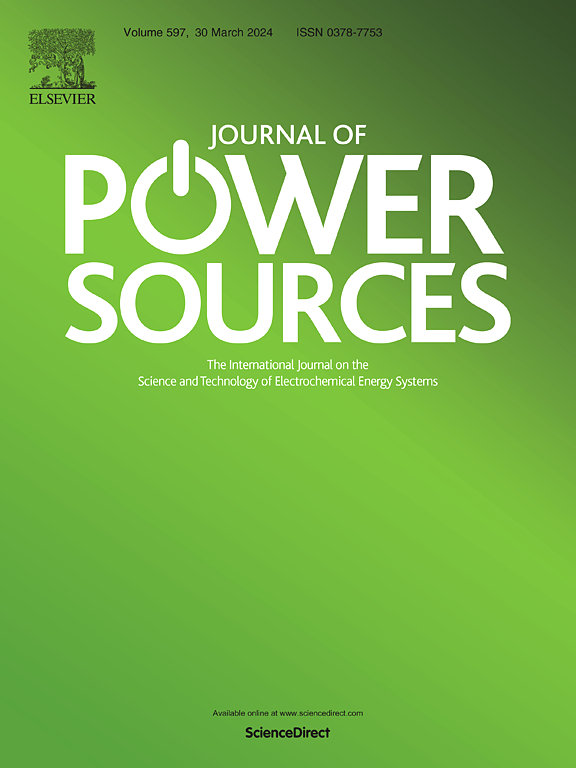具有转换赝电容效应的分级/介孔V3S4@C/石墨烯复合材料的高倍率镁锂混合电池
IF 8.1
2区 工程技术
Q1 CHEMISTRY, PHYSICAL
引用次数: 0
摘要
作为下一代储能系统,非水可充电镁电池(RMBs)的实际应用受到能量密度有限和Mg2+扩散动力学缓慢的阻碍。为了克服这些挑战,本研究提出了一种双碳工程阴极:通过高温硫化和石墨烯杂化合成的v - mof衍生的分层介孔V3S4@C/石墨烯(V3S4@C/G)复合材料。热解碳框架减缓了循环过程中的体积膨胀,而石墨烯增强了电子导电性和Mg2+/Li+共输运。与APC + LiCl/Mg混合电解质相结合,V3S4@C/G阴极在100 mA G - 1时提供了卓越的初始放电容量约500 mAh G - 1,在100次循环后保持83.5%的容量保持率。值得注意的是,即使在1000 mA g−1下循环2000次后,放电容量仍保持在148 mAh g−1,优于传统的Mg电池阴极。通过非原位XRD/XPS进行的机理研究揭示了Mg2+/Li +插入后转化为金属V0和Li2S的两步反应途径。DFT计算表明,V3S4和Li亲和碳界面中的硫空位协同作用使赝电容电荷存储成为可能,Li+扩散势垒降低了0.28 eV。这项工作不仅展示了高性能的硫化物阴极设计,而且建立了一种结合缺陷工程和混合离子传输的多价电池材料优化范例。本文章由计算机程序翻译,如有差异,请以英文原文为准。
Hierarchical/mesoporous V3S4@C/Graphene composite with conversion pseudocapacitance effect for a high-rate Mg-Li hybrid battery
As a next-generation energy storage system, the practical application of non-aqueous rechargeable Mg batteries (RMBs) is hindered by limited energy density and sluggish Mg2+ diffusion kinetics. To overcome these challenges, this study proposes a dual-carbon engineered cathode: a V-MOF-derived hierarchical mesoporous V3S4@C/graphene (V3S4@C/G) composite synthesized through high-temperature vulcanization and graphene hybridization. The pyrolyzed carbon framework mitigates volume expansion during cycling, while graphene enhances electronic conductivity and Mg2+/Li+ co-transport. Coupled with APC + LiCl/Mg hybrid electrolyte, the V3S4@C/G cathode delivers an exceptional initial discharge capacity of ∼500 mAh g−1 at 100 mA g−1, maintaining 83.5 % capacity retention after 100 cycles. Remarkably, the discharge capacity maintains 148 mAh g−1 even after 2000 cycles at 1000 mA g−1, outperforming conventional Mg battery cathodes. Mechanistic studies via ex-situ XRD/XPS uncover a two-step reaction pathway involving Mg2+/Li + intercalation followed by conversion to metallic V0 and Li2S. DFT calculations reveal that sulfur vacancies in V3S4 and Li-affinity carbon interfaces synergistically enable pseudocapacitive charge storage, with reduced Li+ diffusion barriers of 0.28 eV. This work not only demonstrates a high-performance sulfide cathode design but also establishes a material optimization paradigm combining defect engineering and hybrid ion transport for multivalent batteries.
求助全文
通过发布文献求助,成功后即可免费获取论文全文。
去求助
来源期刊

Journal of Power Sources
工程技术-电化学
CiteScore
16.40
自引率
6.50%
发文量
1249
审稿时长
36 days
期刊介绍:
The Journal of Power Sources is a publication catering to researchers and technologists interested in various aspects of the science, technology, and applications of electrochemical power sources. It covers original research and reviews on primary and secondary batteries, fuel cells, supercapacitors, and photo-electrochemical cells.
Topics considered include the research, development and applications of nanomaterials and novel componentry for these devices. Examples of applications of these electrochemical power sources include:
• Portable electronics
• Electric and Hybrid Electric Vehicles
• Uninterruptible Power Supply (UPS) systems
• Storage of renewable energy
• Satellites and deep space probes
• Boats and ships, drones and aircrafts
• Wearable energy storage systems
 求助内容:
求助内容: 应助结果提醒方式:
应助结果提醒方式:


